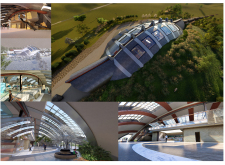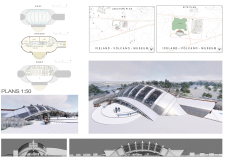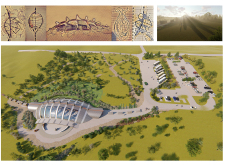5 key facts about this project
The Iceland Volcano Museum is a cultural institution located in a striking volcanic area of Iceland. It is designed to educate visitors about the historical importance of the Viking Ship while engaging them with the unique geological features of the landscape. The design integrates functional spaces with natural elements, creating an environment that invites exploration and appreciation.
Spatial Organization
The layout of the museum emphasizes clarity and ease of movement. Central longitudinal and transverse sections detail the proportions of the Viking Ship, providing insight into the structure's design. A bird's-eye view allows for a better understanding of how different spaces connect within the museum. This organization helps visitors navigate the exhibits comfortably and efficiently, enhancing the overall experience.
Integration with Landscape
The museum's location plan shows a careful relationship with the surrounding geography. Designed to complement the natural features of the volcanic terrain, the building maintains a connection to its environment. This thoughtful design not only improves the museum’s visual appeal but also deepens the connection to Iceland’s geological identity, creating a sense of place that enriches the visitor experience.
Future Forest Concept
A unique element of the design is the “Future Forest” concept, which aims to blend the built environment with natural ecosystems. This idea promotes sustainability through the inclusion of green spaces, encouraging ecological awareness among visitors. Incorporating plants and landscaping enhances the site and its relationship with the vibrant volcanic landscape, creating a welcoming atmosphere that invites exploration.
The detailed design choices focus on creating a clear architectural narrative, featuring simple lines and well-considered proportions that reflect the historical importance of the Viking Ship. Open spaces and strategic sightlines invite interaction between visitors and the surrounding environment, enhancing engagement with both the exhibits and the landscape.






















































